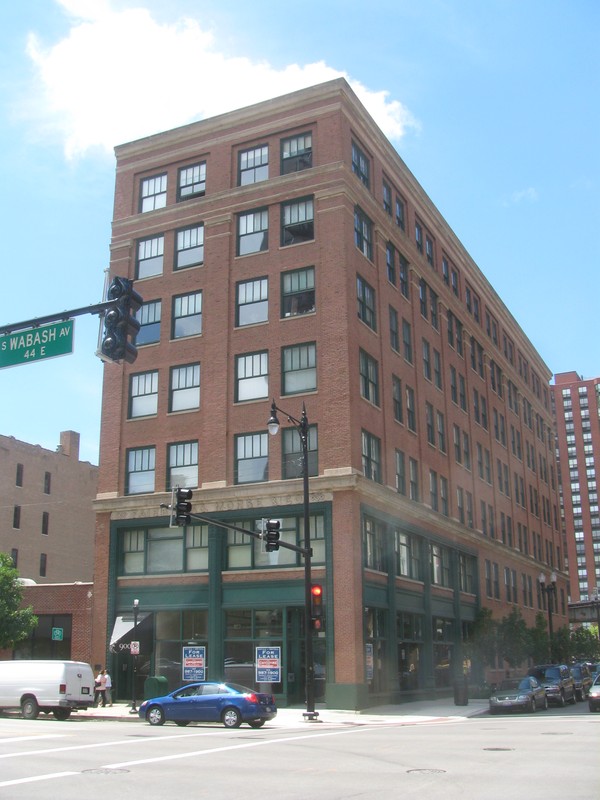Fairbanks, Morse and Company Building
Introduction
Text-to-speech Audio
Images
Source: Wiki Commons

Backstory and Context
Text-to-speech Audio
Although the Fairbanks, Morse & Company building dates back to 1907, the company’s origin arose in 1823 when Thaddeus Fairbanks leased his cousin's iron works operation in St. Johnsbury, Vermont, which allowed him to manufacture two of his patented inventions, a cast iron plow and a heating stove. Thaddeus' brother, Erastus Fairbanks soon joined him and they created the company known as E & T Fairbanks.1
For the next decade, the brothers built machinery, notably the platform scale, which they patented in 1831. Though successful inventors, they needed the help of their other brother, Joseph Fairbanks, who was skilled at marketing. Thus, in 1833 the business was incorporated as E & T Fairbanks & Company. The brothers enjoyed rapid success, opening offices in New York and Boston in the 1830s. By the late 1840s, they opened offices in China and Cuba and by 1860, South America and throughout the Caribbean.2
In the midst of that expansion, during the 1850s, Charles Hosmer Morse joined the company in Boston, working for his uncle. After a three-year apprenticeship, he moved to the New York office, and then after the Civil War he opened his own office to market Fairbanks scales at Cincinnati, Ohio, under the name of Fairbanks, Morse & Company, where he also ran a separate manufacturing company that sold items such as coffee mills, presses, and typewriters, That operation quickly expanded to Cleveland, Pittsburgh and Indianapolis. By 1870, he moved his operations to Chicago and became a partner in the Chicago firm of Fairbanks, Greenleaf & Company.Greenleaf died the following year, and Morse carried on the business independently. However, in 1871, following the Great Chicago Fire, when Morse re-opened the fire-ravaged office, he did so under the name of Fairbanks, Morse & Company.3
By 1875, Morse managed Fairbanks, Morse & Co. offices in Chicago, Cincinnati, Cleveland, Pittsburgh and Louisville, and, in 1880, the company also absorbed the Eclipse Wind Engine Company based in Beloit, Wisconsin. The company did not stop there - they continued to buy other corporations and expand the goods they sold, including pumps, tanks, clutches, and eventually steam engines and railway supplies. By the turn of the 20th century, the company offered an expansive list of goods; its 1901 Mining & Supply Catalog was a 700 page hardbound book.4
About 1906, Fairbanks-Morse began building gasoline powered railcars and during World War II, the company began building diesel locomotives for mainline railroads. By 1963, the company largely dedicated itself to producing diesel locomotives.5
For most of that time, Chicago served as its headquarters, indicative of Chicago's place as the Midwest's largest city, railroad hub, and as a large financial center.6 The National Register of Historic Places describes the building, which was both a showroom, office building, and warehouse:
The first floor, on the east side of the building, housed the
company showroom. It has its own entrance on the north side of the
Wabash front. A small drawing of 900 S. Wabash in Bulletin 3040 (ca.
1920) of the Fairbanks Morse Name Plate shows merchandise in the large
display windows that extend across Wabash and four bays on 9th Street.
There is a large freight elevator at the back of the first floor and wide open berth shipping dock opening onto the back alley. The freight elevator, along with a rear stairway with plastered walls, extends up through the building enabling storage on all floors. Walls on the first floor are sheathed in plaster.
The upper floors are accessed from a second front entrance on the
south wide of the Wabash Avenue facade. It opens into a hall, separated
by a curved firewall from the showroom. The floor is tiled, surrounded
by moldings. The staircase has an iron balustrade. Walls are painted
brick between the basement and the first floor and sheathed in plaster to
the top of the building.
Because the front of the second floor has large Chicago windows flooding the interior with light and air, it is highly likely that this was the area where Company president Charles Hosmer Morse and other top executives managed the sales and distribution of Fairbanks, Morse & Company products. 7
